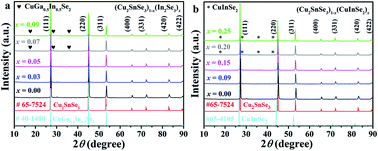Synergistic effect of CuInSe2 alloying on enhancing the thermoelectric performance of Cu2SnSe3 compounds†
Abstract
Cu2SnSe3 based compounds with a diamond-like structure are promising thermoelectric materials. However, the relatively high lattice thermal conductivity limits further improvement in their thermoelectric performance. In this work, two compounds including In2Se3 and CuInSe2 are employed to alloy with Cu2SnSe3 aiming to decrease lattice thermal conductivity and their corresponding effects are compared. It is found that alloying with CuInSe2 is more beneficial to reduce lattice thermal conductivity and maintain the power factor, as evidenced by a higher quality factor B. Subsequently, both In and Ga doping is performed to regulate the carrier concentration of (Cu2SnSe3)0.80(CuInSe2)0.2. Finally, (Cu2Sn0.97Ga0.03Se3)0.80(CuInSe2)0.20 displays a decent zT of ∼0.98 at 823 K, a nearly six-fold higher value compared to that of the pristine sample. Additionally, a zTave of ∼0.35 over 300–823 K is obtained in (Cu2Sn0.97Ga0.03Se3)0.80(CuInSe2)0.20, which is among the best reported p-type Cu2SnSe3 based compounds. The result proves that alloying with CuInSe2 combined with carrier concentration optimization is a valid strategy to improve the thermoelectric performance of Cu2SnSe3 based compounds.



 Please wait while we load your content...
Please wait while we load your content...